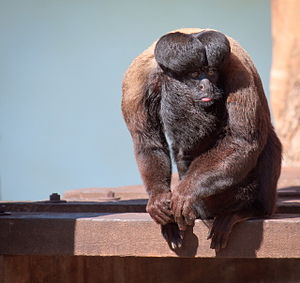Uta-Hick-Saki
| Uta-Hick-Saki | ||||||||||||
|---|---|---|---|---|---|---|---|---|---|---|---|---|

Uta-Hick-Saki at the Brasilia Zoo |
||||||||||||
| Systematics | ||||||||||||
|
||||||||||||
| Scientific name | ||||||||||||
| Chiropotes utahickae | ||||||||||||
| Hershkovitz , 1985 |
The Uta-Hick-Saki ( Chiropotes utahickae ) is a primate species from the group of the New World monkeys (Platyrrhini). It is named after the long-time primate curator of the Cologne Zoo , Uta Hick (later Uta Rümpler), and is sometimes combined into one species with the Satan monkey .
Uta-Hick-Sakis are similar to Satan monkeys, but their fur is more brown than black. They are medium-sized primates with short, thick fur. In adult animals, the head is characterized by a mop of hair and a long beard on the throat. The tail is long and extremely bushy.
Uta-Hick-Sakis are only found in Brazil . Their range is limited in the north by the Amazon , in the west by the Rio Xingu and in the east by the Rio Tocantins . Their habitat are forests, predominantly tropical rainforests .
Little is known about the way of life of the Uta-Hick-Sakis, presumably it corresponds to that of the other Bartsakis. As a result, they are diurnal tree-dwellers who usually move on all fours. They live in larger, mixed groups that split up into smaller subgroups for foraging. Their diet consists mainly of hard-skinned fruits and seeds.
The main threat to these primates is the destruction of their habitat through construction projects and conversion to agricultural areas. In addition, there is hunting for their meat and fur. The IUCN feared a population decline of 50 percent over the next 30 years and lists the species as "critically endangered" ( endangered ).
The species is no longer kept in Europe, former owners are Mulhous, Berlin and Cologne.
literature
- Urbano L. Bobadilla, Stephen F. Ferrari: Habitat Use by Chiropotes satanas utahicki and Syntopic Platyrrhines in Eastern Amazonia. (PDF file; 102 kB) In: American Journal of Primatology. Vol. 50, No. 3, 2000, ISSN 0275-2565 , pp. 215-224 (way of life).
- Thomas Geissmann : Comparative Primatology. Springer-Verlag, Berlin et al. 2003, ISBN 3-540-43645-6 .
- Don E. Wilson, DeeAnn M. Reeder (Eds.): Mammal Species of the World. A taxonomic and geographic Reference. 3. Edition. Johns Hopkins University Press, Baltimore MD 2005, ISBN 0-8018-8221-4 .
supporting documents
Web links
- Chiropotes utahickae in the Red List of Threatened Species of the IUCN 2009. Posted by: L. M. Veiga u. a., 2008. Retrieved November 6, 2009.